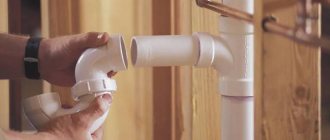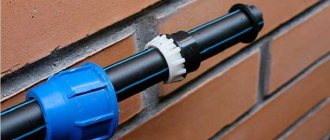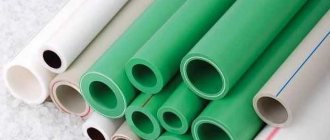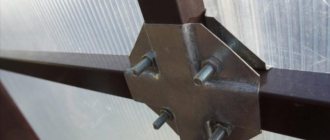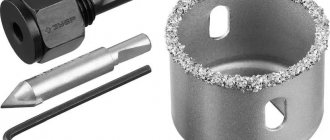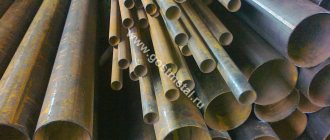Pipelines made of polypropylene, if assembled with high quality, can last up to half a century without repair. The popularity of plastic communications in the construction of individual houses is explained, among other things, by the fact that the installation of polypropylene pipelines can be done independently.
The choice of method for connecting plastic pipes depends on the availability of special tools, the nature of the materials being connected, and the purpose of the communications.
What parts do polypropylene products fit into?
If you don’t know how to connect polypropylene pipes, our explanations will come in handy. This type of pipe is in demand when preparing water supply, heating and irrigation mains. Due to the long service life of polypropylene pipes in the water supply network, which is about half a century, this type is increasingly preferred as a replacement for worn lines. And also these pipes are perfectly combined with auxiliary elements made of steel and polyethylene.
All polypropylene pipes, according to the scope of application, are classified into types:
- Conventional pipes for installation of cold water pipelines (PN 10, 16).
- Universal thick-walled pipes for heating systems that can withstand hot water with a temperature of +80ºC (PN 20).
- Composite pipes having a layer of metal or nylon that is peeled off during soldering. They are used for installation of heating systems, where the maximum temperature of hot water can reach +95ºC (PN 25).
Polypropylene pipe connections are distinguished by the absence of seams between the components of the pipeline.
If their diameter is less than 50 millimeters, you can use all kinds of fittings:
- couplings for connecting sections of the same transverse size;
- crosses to form branches;
- plugs for sealing the ends of the pipe;
- adapters for joining pipe products of various diameters;
- union fittings for connecting pipes with flexible hoses.
If you decide to install propylene pipes yourself, then, first of all, you need to buy or rent a special soldering iron with nozzles.
In addition to it you will need:
- plastic pipe scissors;
- tape measure, marker for marking work;
- cleaning for pipe surfaces.
Welding and installation of a separate part of the pipeline system
When soldering a polypropylene water main, they always try to install individual sections of the water supply in a place with large free space and at a convenient height. To do this, you will need basic tools, a drawing of the highway and the correct procedure for carrying out the work.
Typically the hardest side to weld is on the wall with the two corner fittings, so it is welded first and secured with clips or dowel sleeves. Afterwards, from the corner fittings, further installation of sections of the line is carried out, moving on to soldering work directly near the walls. For ease of installation, it is necessary to provide in advance a place to install the soldering iron on a stand or organize its hanging.
Pipe welding
The joining of the components of the pipeline consists of their mandatory heating and prompt connection of the parts. For welding pipes, household devices with a power of up to a kilowatt are used, which is quite enough for prompt and flawless heating of the material. In industrial production, stronger and more expensive devices are used. By purchasing a special soldering iron for these purposes, you additionally receive attachments for pipes of various diameters. The polypropylene pipe needs to be heated from the outside, and the fittings from the inside.
How to use a soldering iron? Firstly, it needs to be connected to the electrical network and set to the temperature required for heating, which depends on the size of the cross-sections of the plastic pipes to be welded. The average temperature varies from +250̊ to +270̊C.
Secondly, it is imperative to wear protective gloves to avoid burns even at the slightest touch to hot parts. When welding pipes at home, it is important to observe caution and basic safety requirements.
What types of fittings are there?
Fittings are the pipeline elements that are required to connect pipes to each other. So, using these parts, you can join pipes of different sections.
In the manufacture of pipes for supplying various communications, the following materials are used:
- metal;
- polypropylene;
- a combination of two materials - metal-plastic.
You can read about metal-plastic pipes for water supply in our special article.
When choosing suitable connecting elements, it must be taken into account that they must be made of the same material as the pipeline.
Plastic pipes with reinforcement are popular among other products
Pipe soldering
Let's consider connecting pipes using the soldering method:
- Using a hacksaw or sharp scissors that do not deform the plastic, cut the pipes at an angle of 90°. If you don't know how to cut a pipe at an angle, you need to read more information.
- If there are burrs on the end, carefully clean them off.
- Mark the depth of the soldering, i.e. measure a section of a certain length on the pipe to fit into the coupling or tee and draw a line with a marker. Remember that the length of immersion into the connecting element is directly dependent on the diameter of the products. The larger the pipes, the greater the soldering depth.
The algorithm of actions will change slightly if the pipes are reinforced. Then, before the soldering process, it is necessary to process the top layer of the tubular product, including aluminum foil, basalt or nylon fiber. Using a special tool, the required layer size can be easily removed. You need to pay special attention to carefully remove the foil. Even a slight excess of it on the pipe will negatively affect the tightness of the solder joint.
Further steps in the soldering process:
- Place a soldering iron with nozzles that are pre-selected according to the diameter of the pipes on a smooth and reliable surface.
- At the same time, a pipe and fitting are placed on the hot nozzle on both sides, moving it to the marking made with a marker.
- Heat the plastic for a certain time, which depends on the diametrical size of the pipes. For example, if the cross-section of the product is 20 mm, then 6 seconds are enough to heat up; if 32 mm - 8 sec.
- Then the elements are removed from the nozzle and ensure a strong fixation into each other. Never make any turning movements.
- To ensure strong adhesion of the joint, you need to wait 4-10 seconds. This time will be enough for the polypropylene to harden properly and obtain a permanent connection.
Please note that it is very important to adhere to the required heating time. If heating is insufficient, leaks may form. Excessive overheating will lead to sealing of the space inside the pipe and the occurrence of meltdown. You shouldn’t delete it right away, because... heated plastic will begin to deform even more. It is better to wait until the product has completely cooled down and then remove the excess.
Ways to join metal-plastic pipes and PEX pipes
Metal-plastic elements and PEX pipes are often joined using the same method. Here we will describe in detail the technology for installing heat pipes from the above materials.
The connection of metal-plastic pipes is carried out in two ways:
- using compression fittings;
- using press fittings (pressure testing of heating pipes).
Joining pipes with compression fittings
This type of fitting is more convenient to use. Compression fittings can also be used to assemble cold water supply systems. Installation of a pipeline carrying hot water is also carried out by builders using the mentioned fittings.
When assembling the above-mentioned pipelines, there is no need for special equipment for stitching metal-plastic and polypropylene. In order to connect the pipe parts together, you only need a pair of wrenches and pruning shears.
The heating elements are connected according to the following algorithm:
- Initially, a crimp nut is placed on the end of the pipe on the joining side.
- Next, a split-type ring should be put on behind the nut, and the edge of the ring should be placed at a distance of 1 mm relative to the pipe cut.
- Then the pipe is pushed all the way and secured to the fitting fitting. In this case, chamfering the pipe is not required.
- The crimp nut is installed using wrenches.
Compression Fitting Parts and Assembly Procedure
When tightening the nut, it is not recommended to use excessive force, as there is a high probability of cutting through the pipe.
Joining pipes using press fittings
Press-type fittings for metal-plastic pipes, as well as cross-linked polypropylene, make it possible to reliably connect parts of the heating system. Unfortunately, this design cannot be separated in the future. To perform installation in this way, you will need to use a special press tool.
In order to connect the previously mentioned heating elements using fittings, you should follow the following instructions:
- A clamping threaded sleeve must be placed on the end of the pipe.
- Then an expander with the required cross-section is placed into the pipe until it stops.
- The expander handles are slowly connected to each other and fixed in this position for a short time.
- The fitting is inserted into the pipe. Due to its unique molecular composition, the pipes undergo shrinkage, which will help tightly fix the fitting to the pipe.
- The pipe is securely pressed onto the fitting using a manual or hydraulic press.
Crimping using a special tool
Our advice
Before you begin the process of soldering pipes, it is better to perform a couple of practice joints. It is easier to work with small joints by installing the welding machine directly on the table. This way you can check how correctly the pipe soldering is performed.
But attaching elements to a partially finished pipeline will be more difficult:
- Place a soldering iron nozzle on the polypropylene pipe, insert a tee into the other part, holding the welding machine suspended.
- When preparing the main water supply, it is necessary to alternate subsequent connections. In hard-to-reach areas, it is better to avoid joining work due to the difficulty of using a soldering iron.
- The material must be dry and clean, because the presence of dirt and water will reduce the quality of the joint. It is known that the material, if wet, can deform when heated.
- Purchase all products (pipes, fittings) from the same manufacturer, because the chemical composition of elements from different manufacturers may differ, which will ultimately lead to a leaky connection.
- The temperature in the room where work with polypropylene is carried out must be optimal and not lower than +5̊C.
Cost of compression fittings from different manufacturers
Prices for compression fitting connectors depend on the type of material and weight, technical conditions, as well as the manufacturer. Today, the market offers products from both domestic and foreign manufacturers, who offer different prices for their products. Cost may also vary depending on the seller and region.
In order to choose quality products at an affordable price, you need to carefully study their parameters. Characteristics of connecting elements and information about their cost should be found in the catalogs of manufacturers and sellers of plumbing products.
For comparison: parameters and prices of compression fittings for metal-plastic pipes from various manufacturers.
| Company manufacturer | Options | |||||
| Material | Diameter, mm | Maximum pressure, bar | Maximum temperature, °C | Manufacturer's warranty, years | price, rub. | |
| Valtec, Russia-Italy | Brass, stainless steel | 16–32 | 25 | 115 | 10 | from 93 |
| ProAqua, Germany | Brass, Teflon | 16–32 | 10 | 95 | 10 | from 61 |
| Uponor, Finland | Brass, polyamide | 16–25 | 10 | 95 | 10 | from 66 |
| Ape, Italy | Brass | 16–32 | 10 | 95 | 10 | from 106 |
| Rehau, Germany | Brass, stainless steel | 16–40 | 10 | 80 | 1 | from 312 |
Connecting pipes using the crimp method
Often, repairs will require disassembling the pipeline. If the connection of the main components is made by soldering, which is reliable and durable, then disassembling it is almost impossible. Let's look at how to connect polypropylene pipes without a soldering iron, which cannot always be bought or rented from friends. In this case, you will need threaded fittings with a pressure ring, which are called collet fittings (crimp). And for good reason, because this kind of connection can withstand loads of up to 16 atmospheres.
In order to connect the pipeline components together using the crimping method, additional parts will be needed:
- tees;
- soldered and combined couplings with internal and external threads;
- squares;
- adapters with external thread;
- plugs;
- Ball Valves;
- tees with union nut;
- all kinds of threaded fittings;
- sealing rings for socket joints of polypropylene pipes, etc.
You need to pay attention to one nuance: to ensure reliable tightness, all seals and joints are generously treated with silicone.
Further actions:
- Cut off part of the polypropylene pipe.
- Insert it securely into the fitting.
- Wrap the threads of the part with thread to seal.
- Pull the ferrule and nut on top.
- Use a crimp wrench, which you need to take care of in advance, to completely tighten the pipe elements.
Compared to welding, this method takes much more time, but it is very convenient for connecting polypropylene pipes and radiators.
How to connect a plastic pipe to a metal pipe without threads
The connections discussed above were based on the fact that a fitting having a thread for connecting to a metal part having a mating threaded part was soldered or attached in some way to the plastic pipe. This technology is generally accepted and ensures high quality, tightness, and strength of the connection; its only and main drawback is the impossibility of joining with pipes that have a smooth surface. It should be noted that it is impossible to directly connect a plastic pipe to an iron pipe without threads when laying any type of utility lines; technology has been developed to connect them using electric-welded couplings and NSPS transition elements.
Docking combination of metal and polypropylene
When installing plumbing and heating systems, there are places where it is necessary to connect steel and plastic pipes. For such cases, you will need special adapter fittings, which have a smooth hole for a plastic pipe on one side, and a threaded metal insert on the other. Therefore, the polypropylene pipe is joined by welding, and the steel pipe is tightened with a crimp wrench. As a result, the resulting connection is inferior in strength to a welded one, but will still last for many years.
Please note that upon completion of installation work, it is necessary to conduct a test run of water in the system. This way you can check the tightness of the joints of pipes and pipeline components. Threaded connections may leak and must be immediately tightened with a wrench.
As you can see, you can independently install a plumbing or heating system from polypropylene pipes. The main thing is to impeccably comply with the requirements of the instructions for using the welding machine and the installation technology. Watching a video on this topic will be very useful.
How metal-plastic and polypropylene pipes are joined
There is only one way to install pipes made of different materials. This is a threaded installation, since soldering and gluing products cannot be used here.
This is explained by the fact that the joint must not only be hermetically sealed, but also be able to experience high dynamic loads (maximum pressure difference).
Quick installation of pipes from various materials Source glawtruba.ru
Before connecting a metal-plastic pipe with a polypropylene pipe, you need to select the necessary parts:
- Metal-plastic products are equipped with special tips.
- Polypropylene sections, in turn, are equipped with a coupling on which a thread is applied.
Compound of polyethylene and polypropylene
This option of the line involves the purchase of special fittings. They will be needed if water enters the building through HDPE pipes and is subsequently diluted using polypropylene pipes. In such cases, soldering of HDPE pipes with a soldering iron for polypropylene is quite often carried out, which is quite acceptable.
Let's consider two cases of how to connect polypropylene pipes without welding with polyethylene pipes:
- A threaded coupling is attached to the HDPE product, on one side of which there is a clamp connection. A similar threaded coupling is also mounted on the end of the polypropylene pipe, with a solder joint on one end and a threaded joint on the opposite end. To avoid leaks and achieve high-quality joining, tow or FUM tape is applied to the threads.
- Using a flange connection. The rubber seal is located between the flanges, which are bolted together.
Using flanges
This connection is made using adapter bushings welded to the ends, or slip-on steel flanges (profiled and smooth) with threads on one side. They are installed without welding. Among the advantages, the high reliability of the joints is noted, withstanding high temperatures and pressures of up to 16 atm. The connection can be made on pipelines of different diameters from 2 to 120 cm.
Docking begins by pulling the flange onto the pipe and putting on the rubber gasket. It is installed at a distance of no more than 10 mm from the end. The flange is moved towards the gasket, and another pipe is prepared in the same way.
The bolts are tightened carefully so as not to crack the plastic.
Flange connection of plastic pipes
Installation features
The connection of individual sections of a conducting hydraulic main can occur in two different ways - detachable and permanent . How to connect HDPE pipes without welding - with fittings? The choice of method is determined by the purpose of this structure.
A permanent connection is most often used if liquid will be supplied there under pressure.
The end-to-end fastening of pipeline fragments is carried out using mechanical or electro-hydraulic welding. Detachable water pipelines are created in the case of installation of gravity systems. For example, this could be a home sewer system, where water will definitely not flow under pressure. Devices from elements of small cross-section, from 50 mm and below, and conductive lines are also assembled using a dismountable method, where a change in configuration is obviously expected during the operation of the pipeline.
The detachable combination of HDPE pipes can be flanged, coupling, collet crimp, that is, by means of fittings . This method is considered the most technologically advanced and less labor-intensive.
Also, connecting spare parts are mounted in places where the conductive line is expected to be disassembled for the purpose of repair, connecting additional elements or changing the configuration.
How to choose a soldering iron
If you solder polypropylene pipes once, skip this point, but when such a tool is needed for work or you plan to install a system of plastic pipes for your mother-in-law, godfather, brother, matchmaker, etc., then buying a soldering iron is issue No. 1.
Soldering iron characteristics:
- The compactness of the device, how comfortable it sits in the hands;
- Equipment power;
- Basic equipment (over time you buy different attachments, but at first, if the required attachment is not in the set, it is better to buy it right away, so as not to run to the store for it later);
- Soldering iron material.
Compactness is important. After all, you will have to keep the device suspended for a long time. Because of this, after the next pipe, your hands will begin to get very tired. Therefore, before buying a soldering iron, take it in your hands and try how convenient it is to work with it.
Power determines which pipes can be welded. The voltage of 220 V is taken as the reference point, to which the soldering iron is connected. Builders use very powerful devices. But in private practice, completely different characteristics are needed (power depends on the diameter of the hole):
- 16 – 63 mm. – 700 W;
- 63 – 73 mm – 850 W;
- 125 mm. – 1200 W;
- 125 – 150 mm. – more powerful heating tools.
The equipment consists mainly of attachments. The more nozzles the manufacturer provides, the more pipes the device can solder. All of them have a pair (for two products at the same time). Some devices join several pipes at the same time with different diameters. It is recommended to use Teflon coated tips. They are more durable.
Manufacturer. The Czech Republic is a country that produces the best soldering irons. It is their equipment that is considered the most expensive and high quality. Following the Czechs are the Turks, but among them there are many Chinese fakes.
China is not considered a very bad manufacturer. But it depends. You can get a good quality one from China or buy a cheap model that will fail after several repairs. To solder two polypropylene pipes, you need to be patient, attentive and, preferably, a good partner. The presence of a soldering iron plays a very important role, but there are analogues in the absence of a heating tool. If you do not understand the work, it is better to hire a specialist.
Connection methods
Pipe joining methods are divided into 2 types:
- one-piece, which are created by welding;
- detachable (installation is carried out using fittings).
Plug-in connection
This type of connection of individual pipeline elements is used when in the future there may be a need for dismantling or welding cannot be used.
There are 2 types of these connections:
- bell-shaped, for which you need to use seals made of rubber;
- fitting or flange, performed using special fastening elements.
Fixation in a socket is used for gravity sewer systems. However, such a connection has poor tightness.
When connecting pipelines d < 35 mm, compression fittings are used. After dismantling the connection, the compression sleeve can be reused. Installation work is carried out as follows:
- It is necessary to disassemble the fittings by unscrewing the nuts 2-3 turns.
- Then you need to clean the surface of the pipes from dirt and chamfer the outside.
- After this, the depth of entry into the fitting should be determined on the pipes, and the ends should be moistened with liquid soap.
- The pipeline parts must be inserted into the connecting elements, and then the nuts must be tightened.
For a larger diameter pipeline, it is necessary to use fittings with a split ring, which is put on at the end of installation. To secure threaded connections you do not need complex equipment. But at the same time it is necessary to control the amount of force applied, otherwise the pipeline elements may be damaged.
A flange connection is often used to connect a pipeline made of low-density polyethylene to metal. The connection is made using bolts that fix the end of the flange on the sleeve of the HDPE pipe with the end of the flange, which is welded to the metal structure.
HDPE products with threads at the ends are used as a protective sheath for laying power or telephone lines. One of the structures has an external threaded connection that matches the internal one on the other. The pipeline parts are joined together using the twisting method.
Permanent connection
This connection method is performed using different types of welding and is intended for joining large-diameter pipelines (more than 50 mm). The resulting connection is highly durable, which allows it to be used in areas with high pressure.
There are permanent connection methods such as:
- butt welding;
- electric welding.
Butt welding is performed by heating the ends of HDPE pipes to a viscous state using a heating element. After which the pipeline parts are connected to each other, and then released after the seam has completely cooled.
Sequence of work:
- Pipes should be cleaned of dirt.
- Then the ends of the pipeline parts need to be installed in the ring clamps of the welding equipment and centered.
- After this, carry out trimming using special knives and further inspection to determine the accuracy of the match.
- Then the prepared surfaces are heated with a heating element and subsequently melted.
- Then you should remove the heating device, connect the pipes together under pressure and settle the joint.
- After completing the welding work, the seam is cooled. When cooled, the required strength is achieved.
To perform electrofusion welding, special connectors (couplings) are used. A low-temperature electric coil is mounted inside them. When voltage is applied, it heats up and welds the pipeline elements to the inner walls of the fittings.
Welding is performed with specialized equipment subject to the following rules:
- mandatory preliminary cleaning of pipes;
- ensuring the immobility of the connected parts during heating and cooling.
Sequence of work:
- First, you should cut the ends at right angles and chamfer them.
- Then you need to clean the surfaces of the parts to be joined.
- After this, fix the pipes inside the coupling and connect power supply wires (terminals) to its mechanical clamps.
- Then turn on the device and wait for the plates to heat up, through which the inner surface of the polyethylene is softened.
- Then you need to turn off the equipment and remove the wires.
- Finally, you need to cool the resulting compound.
To ensure a long service life of communications, when choosing a method for joining HDPE pipeline elements, you need to take into account all the nuances of their installation, as well as follow the assembly rules.
Transitional coupling for reliable connection
The polypropylene transition coupling, as well as the split polypropylene coupling, are used for the installation of pipelines. It is lightweight, minimizes labor and time costs for pipeline installation, and is characterized by a long service life, practicality, durability and reliability due to the quality of workmanship and the material endowed with special properties.
The polypropylene transition coupling differs in type and diameter; it is selected based on the type and diameter of polypropylene pipes. Its feature is to ensure high connection reliability. Even after a long service life, it will not lose its properties and will clearly perform ozone functions.
